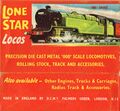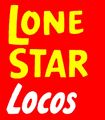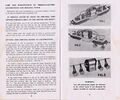Category:Lone Star
| Toy Brands and Manufacturers |
|---|
Lone Star |
| 1950 - |
1955: "Lone Star production goes up and up". Note the selection of toys around the page edge, mostly "Cowboys and Indians"-related [image info]
1964: D-Day Invasion Set [image info]
The Die Cast Machine Tools Company (DCMT ~1939-1983), started out just before World War Two, manufacturing diecasting machines and equipment.
DCMT had initially manufactured some cast metal toys for Crescent, and then started manufacturing in their own right. Since "DCMT" was slightly cryptic (and the full name was unhelpful for a toy brand), the company picked the name Lone Star as their toy brand, which (at eight letters plus a space) was still reasonably short and easy to letter on the base of small cast items.
The brand
The "Lone Star" brand was tailored for "Wild West" - related toys – children's enthusiasm for playing "Cowboys and Indians" after the war (fuelled by Hollywood films) created a demand for diecast toy cap-firing guns, which DCMT was ideally placed to satisfy. While "Lone Star" was a reference to the single star on the state flag of Texas (the "lone star state"), it also resonated with "The Lone Ranger", and with the five-pointed star sheriff's badge that children would be familiar with from films and "cowboy" play costumes.
DCMT invested heavily in promoting their "Cowboys and Indians"-themed brandname, organising events and competitions and hiring Roy Green to play the cowboy "Steve Larrabee". This led to a strong enough brand recognition with toyshops that the company applied the brandname to their newer ranges of toys (such as model trains and cars) that were nothing to do with cowboys. This led to the slightly perplexing situation of a train set made by a British company with British-style locos and rolling stock being marketed to British families under an American-sounding name, causing many people to assume that the company must be American.
Product ranges
While Lone Star continued producing a wide range of diecast metal toy guns (including, in later days, a licensed James Bond toy Walther PPK), and are mostly remembered nowadays as a maker of "cap guns", they seem to have taken a keen interest in what other diecast toymakers were doing, resulting in a product lineup that ranged from the slightly derivative/generic to the genuinely innnovative.
Trains
- Lone Star Locos appeared in the late 1950s as a range of fairly basic 000-scale diecast miniature trains and track (similar-looking to the old Dinky Toys miniature push-along trains, but with clip-together diecast track). Where gauge 0 track was 32-and-a-bit-millimetres wide, "000" would be expected to be a quarter of this, or somewhere around eight-and-a-bit millimetres, and this Lone Star range used a size of about 8.5mm.
- The 1960s saw the appearance of the comparatively short-lived "Treble-O-Lectric" range of "proper" motorised 000-scale electric train sets, with a slightly larger 9mm gauge. This made Lone Star arguably the pioneers of commercial N gauge.
Cars
- Impy Toys were an attempt to compete with the diecast toy cars already being made by Dinky and Corgi.
- Lone Star Flyers represented the company's attempt to update their Impy range to have low-friction axles to compete with the threat of Mattel's new (market-disrupting) Hot Wheels range.
- Roadmaster Majors were then the range of larger Impy vehicles – typically buses and lorries – which were not suitable for the "low friction, high speed" treatment. This also included a tractor, a Jeep and trailer, and (wierdly) a much larger-scale Jaguar sports car.
- Lone Star Commercials represented more modern versions of commercial vehicles – where the "Majors" tended to have long engine bonnets, the "Commercials" tended (with the exception of the tractors and the Number 31 Breakdown Truck) to have flat-fronted high-visibility cabs.
- Top Boy were "chunky" stylised vehicles aimed at the Tonka Toys market, and,
- Tuf-Tots were aimed at the market for smaller-sized cheaper toy vehicles, led by Matchbox, which Corgi also tried to penetrate with their Husky/Corgi Juniors range.
Other
The company also made other toys that didn't easily fit into a range, such as the 1210 Giant Construction Crane, and there was an "International Peace Force" range of pretty standard army vehicle types, but finished in "United Nations" blue rather than drab green, and with odd silver detailing.
1955 trade promotional text:
A new factory has been built at Hatfield, Herts, England. This will enable us to increase production of Lone Star products, and to introduce even more new lines to our ever popular range of toys.
Lone Star products are backed right through to the public to help increase your sales. As part of our Dealer-aid Service we are continuing to organize throughout the country such attractions as road shows, nation-wide competitions for children, and special store displays. The Lone Star Magazine with its national circulation, provides valuable publicity from which you and we benefit.
— , Lone Star, , British Playthings Overseas, , 1955
1963 promo text:
Lone Star
In 1963 Lone Star will be concentrating on improving their Treblolectric rolling stock, both passenger and goods. They will be diecast and have greater detail, with nylon bearings as well as axles, thus reducing the friction. All locomotives will be tested to pull not less than four coaches, but up to twenty-five coaches have been hauled by one locomotive on their test track. A new improved controller and a range of structures, motor vehicles and figures are also in preparation.
— , -, , Railway Modeller, , January 1963
Factory photos:
photos supplied by Jonathan Thorpe
See also:
External links
Subcategories
This category has the following 5 subcategories, out of 5 total.
I
- Impy Toys (9 F)
L
- Lone Star Flyers (2 F)
- Lone Star Treble-O-Lectric (1 P, 10 F)
T
- Top Boys (empty)
Pages in category ‘Lone Star’
This category contains only the following page.
Media in category ‘Lone Star’
The following 54 files are in this category, out of 54 total.
- A4 Gresley Streamliner, Lone Star Locos (LSLBroc).jpg 2,122 × 897; 602 KB
- Accessory packing section (Lone Star Treble-O-Lectric).jpg 3,000 × 2,295; 1.39 MB
- American Transcontinental Diesel, Lone Star Locos (LSLBroc).jpg 1,419 × 799; 376 KB
- Beatties Pastimes Review No3, Xmas 1967, p3 (MM 1968-01).jpg 888 × 1,200; 470 KB
- Brake Van, Lone Star Locos (LSLBroc).jpg 813 × 617; 183 KB
- Cattle Wagon, Lone Star Locos (LSLBroc).jpg 817 × 563; 175 KB
- Chrysler Imperial, Impy Super Cars (AirfixMag 1966-09).jpg 971 × 1,200; 536 KB
- Class 3 2-6-2 Tank Loco, Lone Star Locos (LSLBroc).jpg 1,269 × 1,009; 379 KB
- Class 3F 0-6-0 Tank Loco, Lone Star Locos (LSLBroc).jpg 1,278 × 792; 231 KB
- Competition winner visits the Palmers Green factory (Lone Star).jpg 2,243 × 3,000; 1.56 MB
- D-Day Invasion Set, Lone Star Products (MM 1964-12).jpg 1,933 × 1,236; 315 KB
- Diecast toy car production line (Lone Star).jpg 2,202 × 3,000; 1.11 MB
- Diesel Locomotive D5900, boxed (Lone Star TrebleOlectric EL-61).jpg 3,200 × 1,231; 1.86 MB
- Diesel Locomotive D5900, side view (Lone Star TrebleOlectric EL-61).jpg 3,200 × 1,012; 1.42 MB
- Diesel Locomotive D5900, underside (Lone Star TrebleOlectric EL-61).jpg 3,200 × 1,702; 1.74 MB
- Diesel Passenger Train Set EL-51, box lid (Lone Star TrebleOlectric).jpg 3,200 × 2,139; 3.71 MB
- Diesel Passenger Train Set EL-51, contents (Lone Star TrebleOlectric).jpg 3,200 × 2,130; 3.06 MB
- Diesel Shunter, 0-6-0, Lone Star Locos (LSLBroc).jpg 1,091 × 825; 285 KB
- Eric Eastwell and AR Mills, Lone Star (circa 1950).jpg 3,000 × 2,212; 1.23 MB
- Flat Truck, Lone Star Locos (LSLBroc).jpg 695 × 376; 93 KB
- Foden Open Truck, box artwork (Impy Toys 24).jpg 2,320 × 1,138; 976 KB
- Foden Open Truck, opened box (Impy Toys 24).jpg 1,800 × 746; 886 KB
- Foden Open Truck, pack description (Impy Toys 24).jpg 1,800 × 651; 891 KB
- Foden Tilt-Cab Truck, Impy Toys (MM 1967-07).jpg 2,422 × 3,000; 2.92 MB
- Goods Wagon (Lone Star Locos).jpg 800 × 456; 150 KB
- Goods Wagons, Lone Star Locos (LSLBroc).jpg 1,096 × 542; 199 KB
- Impy Toys, Logo, colour.png 894 × 433; 191 KB
- Impy Toys, logo.jpg 551 × 243; 40 KB
- Lone Star factories, Palmers Green and Hatfield (BPO 1955-10).jpg 2,672 × 1,302; 686 KB
- Lone Star Flyers, listing (LoneStar 1975).jpg 2,869 × 3,000; 1.74 MB
- Lone Star Locos leaflet, front and back.jpg 1,024 × 753; 389 KB
- Lone Star Locos leaflet, interior.jpg 1,024 × 756; 385 KB
- Lone Star Locos track, underside.jpg 2,200 × 1,467; 2.06 MB
- Lone Star Locos, box, flat.jpg 2,324 × 2,150; 1,011 KB
- Lone Star Locos, logo.jpg 658 × 751; 49 KB
- Lone Star Locos, selection.jpg 1,600 × 1,039; 627 KB
- Lone Star logo.jpg 1,456 × 220; 45 KB
- Lone Star production goes up and up (BPO 1955-10).jpg 1,971 × 3,000; 4.9 MB
- Original pattern and final Lotus toy car (Lone Star).jpg 3,000 × 2,213; 1,009 KB
- Passenger Carriage, EL-071.jpg 3,200 × 1,097; 1.43 MB
- Passenger Carriage, EL-70 (Lone Star TrebleOlectric).jpg 3,200 × 885; 1.24 MB
- Passenger Coach, BR Express, Lone Star Locos (LSLBroc).jpg 1,733 × 674; 361 KB
- Passenger Coach, BR Midland, Lone Star Locos (LSLBroc).jpg 1,188 × 662; 250 KB
- Princess Royal Class Passenger Loco, Lone Star Locos (LSLBroc).jpg 2,108 × 871; 533 KB
- Product range listing, box side (Impy Toys).jpg 1,800 × 853; 1.08 MB
- Publicity photos of a child surrounded by diecast toy cars (Lone Star).jpg 3,000 × 1,846; 1.21 MB
- Station, Lone Star Locos (LSLBroc).jpg 4,031 × 799; 578 KB
- Tank Wagon, Lone Star Locos (LSLBroc).jpg 647 × 515; 127 KB
- Track sections, Lone Star Locos (LSLBroc).jpg 2,298 × 1,324; 692 KB
- Treble-O-Lectric Railways, Instruction Manual, cover (Lone Star).jpg 1,200 × 993; 452 KB
- Treble-O-Lectric Railways, Instruction Manual, loco internals (Lone Star).jpg 2,200 × 1,836; 869 KB
- Treble0Lectric logo.jpg 1,806 × 413; 138 KB
- Volkswagen Micro Bus, Impy Super Cars (AirfixMag 1966-10).jpg 971 × 1,200; 526 KB























































